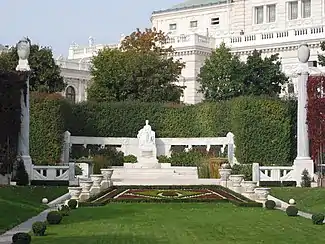

Hans Bitterlich (28 April 1860, Vienna - 5 August 1949, Vienna) was an Austrian sculptor.
Life and work
His father was the sculptor and history painter, Eduard Bitterlich. He studied with Edmund von Hellmer and Kaspar von Zumbusch, and was a professor at the Academy of Fine Arts, Vienna, from 1901 to 1931.
His best known works include a monument to Gutenberg in the Lugeck district (1900), and the monument to Empress Elisabeth in the Volksgarten, both with an architectural framework by Friedrich Ohmann.[1]
In 1943, he was awarded the Goethe-Medaille für Kunst und Wissenschaft, and placed on the Gottbegnadeten list of Joseph Goebbels, as an important artist of the Nazi state.[2]
He was interred in the Wiener Zentralfriedhof in a Gewidmete Gräber der Stadt Wien (Dedicated Grave).[3]
References
- ↑ "Kaiserin Elisabeth-Denkmal in Wien" from the Illustrirtes Wiener Extrablatt, 31 December 1903
- ↑ Ernst Klee (2009), Kulturlexikon zum Dritten Reich: Wer war was vor und nach 1945 (in German) (1. ed.), Frankfurt am Main: S. Fischer, p. 51, ISBN 978-3-596-17153-8
- ↑ Grabstelle Hans Bitterlich Archived 2020-07-20 at the Wayback Machine, Wien, Zentralfriedhof, Gruppe 32, Gruppe Erweiterung A, Nr. 51.
Further reading
- "Hans Bitterlich" @ University of Vienna, Monuments
- "Bitterlich Hans". In: Österreichisches Biographisches Lexikon 1815–1950 (ÖBL). Vol. 1, Austrian Academy of Sciences, Vienna 1957, p. 88.
External links
- Hans Bitterlich in Austria-Forum (in German) (at AEIOU)
- Hedwig Abraham (Ed.): "Ehrengrab von Vater und Sohn Bitterlich auf dem Wiener Zentralfriedhof" @ Viennatouristguide